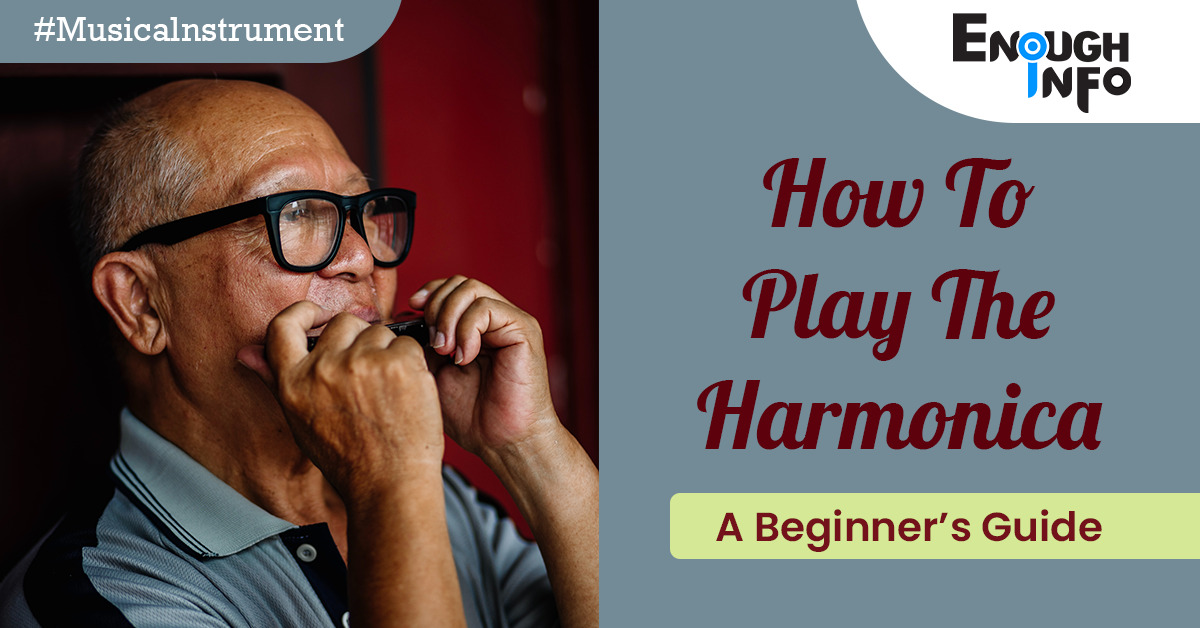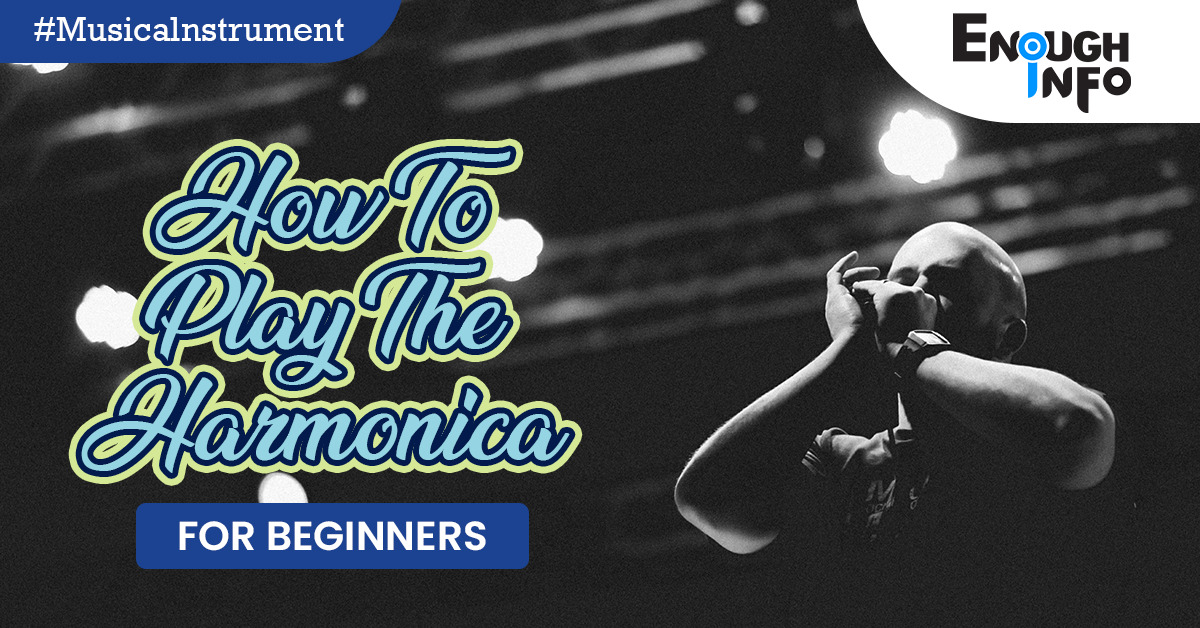How To Play The Harmonica For Beginners

How To Play The Harmonica For Beginners: The harmonica is a versatile and portable musical instrument that has captivated generations of musicians and enthusiasts. Whether you’re drawn to its soulful bluesy sound or its ability to add a unique touch to any musical genre, learning to play the harmonica is an exciting journey. Playing the harmonica can have positive effects on personal growth and well-being. EnoughInfo.com

It provides a sense of accomplishment as beginners progress and master new techniques. The act of playing music can also be therapeutic, reducing stress, improving focus, and promoting mindfulness. It can serve as a form of self-care and a means of relaxation. How To Clean A Clogged Drain
Learning how to play the harmonica for beginners is important because it provides accessibility to music, fosters self-expression, offers versatility in musical genres, and builds essential musical skills. It also facilitates connections with musical communities and contributes to personal growth and well-being. So, grab a harmonica, start your musical journey, and discover the joy of playing this wonderful instrument.
Read Also: How To Play The Violin For Beginners
FAQs & Answers
1. Do I need any prior musical experience to play the harmonica?
No, you do not need any prior musical experience to start playing the harmonica. It is a beginner-friendly instrument that can be learned by anyone with dedication and practice.
2. How long does it take to become proficient in playing the harmonica?
The time it takes to become proficient in playing the harmonica varies from person to person. With regular practice and dedication, you can start playing simple songs within a few weeks or months. Mastery and proficiency will come with continued practice and exploration of advanced techniques. How To Start A Successful Podcast
3. Can I play different genres of music on the harmonica?
Yes, the harmonica is a versatile instrument that can be played in various genres, including blues, folk, rock, country, jazz, and more. The techniques and playing styles can be adapted to suit different musical genres.
4. What are some recommended resources for learning the harmonica?
There are several resources available for beginners to learn the harmonica. Online tutorials, instructional videos, harmonica lesson books, and interactive apps can provide valuable guidance and practice materials. Additionally, joining harmonica forums or local harmonica clubs can connect you with experienced players who can offer guidance and support.
Read Also: How To Play The Ukulele (For Beginners)
5. How do I take care of my harmonica?
To ensure the longevity and optimal performance of your harmonica, it’s important to take proper care of it. After playing, gently tap the harmonica on your hand to remove any moisture, and store it in a clean and dry place. Avoid exposing it to extreme temperatures or direct sunlight. Cleaning the harmonica regularly with a soft cloth and using a harmonica case for storage can help maintain its condition. How To Make A DIY Face Mask For Oily Skin
6. How can I improve my breath control for better harmonica playing?
Breath control is a crucial aspect of harmonica playing. Regular practice, including exercises like long sustained notes and playing scales with controlled breath, can help improve breath control. Additionally, practicing diaphragmatic breathing techniques can enhance your overall control and stamina.
A Comprehensive Guide to Playing the Harmonica for Beginners

In this comprehensive guide, we will walk you through the basics of playing the harmonica and provide you with essential tips and techniques to help you get started on your harmonica-playing adventure.
1. Choosing the Right Harmonica
Before diving into playing the harmonica, it’s important to choose the right instrument. There are different types of harmonicas, including diatonic, chromatic, and tremolo harmonicas. For beginners, the diatonic harmonica is the most commonly recommended choice due to its simplicity and affordability. Diatonic harmonicas are available in different keys, and the key of C is often recommended for beginners as it is versatile and widely used.
Read Also: How To Play The Flute For Beginners
2. Holding the Harmonica
To begin playing the harmonica, you need to learn the proper way to hold it. Hold the harmonica between your index and thumb fingers, with the cover plate facing you. Your other hand is free to use for cupping and modifying the sound. Make sure to relax your hands and maintain a comfortable grip to ensure ease of playing and control.
3. Learning the Basic Techniques
(a) Single Notes: Start by practicing single notes, which involves playing one hole at a time. Position your mouth over a single hole on the harmonica, creating a tight seal with your lips. Use your tongue to block the adjacent holes, allowing air to flow through the desired hole and produce a clear sound.
(b) Pucker Technique: The pucker technique involves forming your lips into a small circular shape and blowing or drawing air through the harmonica. This technique is commonly used for playing melodies and single notes.
(c) Tongue Blocking: Tongue blocking involves placing your tongue across multiple holes to block unwanted airflow while allowing air to pass through specific holes. This technique provides more control and enables you to play chords and produce various bending effects. How To Write A Captivating Blog Post
4. Understanding the Layout of the Harmonica
A standard diatonic harmonica consists of 10 holes, each producing different notes when blown or drawn. By familiarizing yourself with the layout of the harmonica, you can easily navigate and play different melodies. The holes are numbered from 1 to 10, starting from the left side. The blow notes are in the middle of each hole, while the draw notes are on the right side.
5. Learning Basic Songs and Melodies
To build your harmonica playing skills, start by learning some basic songs and melodies. Begin with simple tunes that use a limited number of holes and progress gradually to more complex songs. There are plenty of online resources, tutorials, and sheet music available for beginners. Practice regularly and take your time to master each song before moving on to the next.
Read Also: How to play guitar chords(All You Need To Know)
6. Bending Notes
One of the signature techniques in harmonica playing is bending notes. Bending refers to altering the pitch of a note by manipulating the airflow and shape of your mouth. It adds expressive depth to your playing and allows you to play the bluesy “bent” notes associated with harmonica music. Bending notes requires practice and control, so be patient and start with gentle bends before attempting more advanced bending techniques.
7. Vibrato and Trills
Adding vibrato and trills to your harmonica playing is a great way to express yourself through your music. Vibrato is an effect achieved by subtly altering the airflow throughout a note’s performance, causing the pitch to oscillate. Trills, on the other hand, involve rapidly alternating between two adjacent notes to create a fast and lively sound. To practice vibrato, start by playing a sustained note and gradually introduce small variations in airflow to create the wavering effect. Trills can be practiced by rapidly switching between two adjacent holes or notes while maintaining a steady rhythm. How To Remove Pet Hair From Furniture
8. Playing Chords
Aside from playing single notes and melodies, learning to play chords on the harmonica can expand your musical possibilities. Chords are created by playing multiple notes simultaneously, producing a harmonized sound. Tongue blocking technique is commonly used for playing chords. Experiment with different combinations of holes to create major, minor, and seventh chords. Practice switching between chords smoothly to develop your chord-playing skills.
9. Developing Breath Control
Breath control is crucial for achieving a consistent and controlled sound on the harmonica. Practice controlling your breath by focusing on techniques like maintaining steady airflow, controlling the strength of your breath, and learning when to draw or blow with varying intensity. Developing good breath control will help you play with dynamics, and expressiveness, and achieve the desired tonal qualities.
10. Improvisation and Experimentation
Once you have a solid foundation in harmonica playing, it’s time to explore your creativity and experiment with improvisation. Improvisation allows you to create unique melodies, riffs, and solos on the spot. Start by familiarizing yourself with different scales and patterns that work well on the harmonica, such as the blues scale or the major pentatonic scale. Play along with backing tracks or jam with other musicians to enhance your improvisation skills and develop your musical ear. How To Start A Successful Online Store
11. Practice Routine and Persistence
Like any musical instrument, mastering the harmonica requires consistent practice and persistence. Set aside dedicated practice time each day, even if it’s just a few minutes. Focus on specific techniques, songs, or areas that need improvement. Break down challenging passages into smaller segments and practice them gradually, gradually increasing speed and accuracy. Recording yourself and listening back can also be helpful in identifying areas for improvement.
Read Also: How to play the piano by ear(step-by-step guide)
Conclusion
Learning to play the harmonica is an exciting and rewarding journey that offers endless possibilities for musical expression. By following the tips and techniques outlined in this comprehensive guide, beginners can lay a solid foundation for their harmonica playing skills. Remember to choose the right harmonica, learn the basic techniques, familiarize yourself with the instrument’s layout, and practice regularly. With time, patience, and dedication, you can become a proficient harmonica player, unlocking the joy of creating soulful melodies and captivating audiences with your unique sound. So, grab your harmonica, let the music flow, and enjoy the harmonious adventure that awaits you! How to make homemade body scrub
Recommended;
How to have a good singing voice (Top 14 Tips)
How To Play the Guitar For Kids
17 Things To Do If You Feel Like Giving Up




